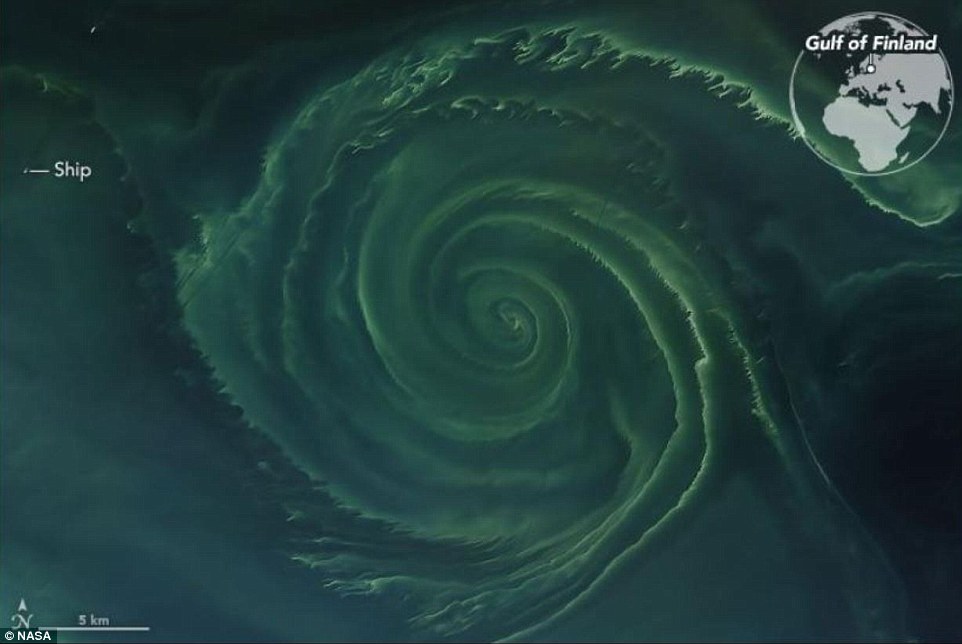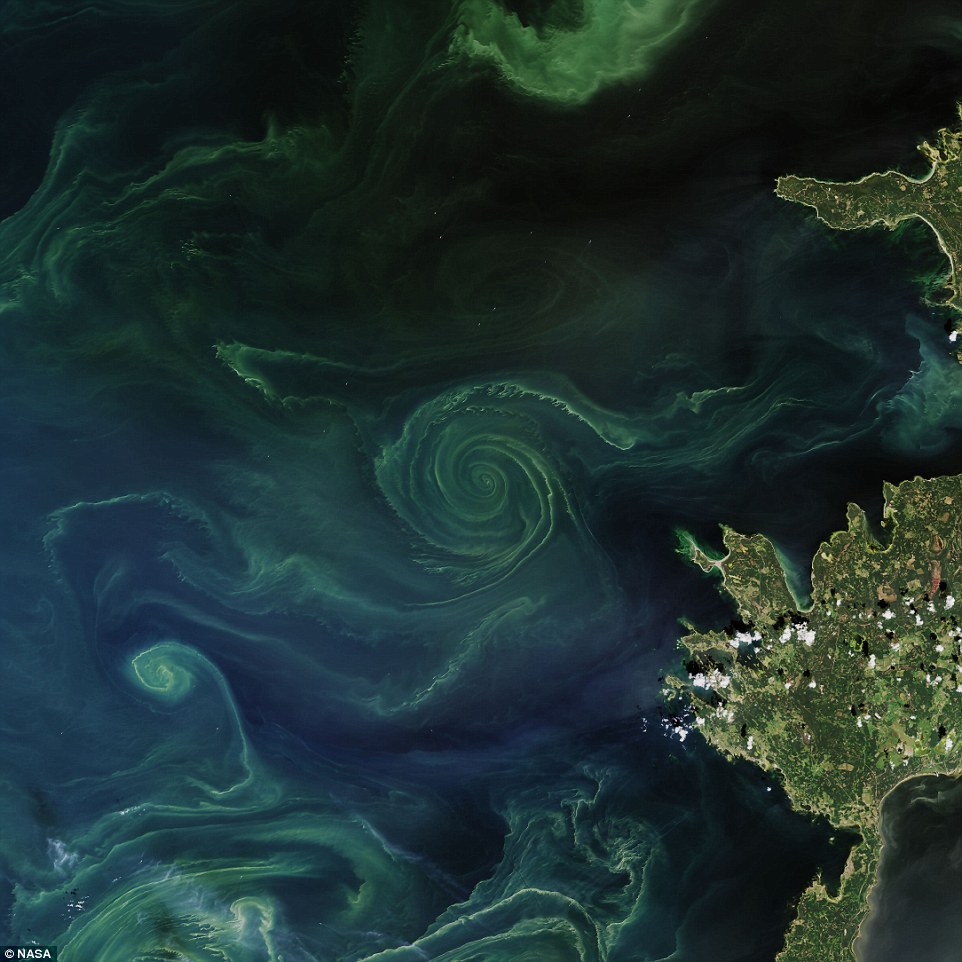Every summer, phytoplankton spread across the northern basins of the North Atlantic and Arctic Oceans, with blooms spanning hundreds and sometimes thousands of kilometers. NASA has revealed an incredible image of a gigantic ‘whirlpool’ of algae in the Baltic sea. Blooms this summer off of Scandinavia seem to be particularly intense.

The swirling bloom is at least 15 miles across, which means New York City’s Manhattan Island could fit inside it with a little room to spare.
Researchers are unsure what is causing the strange pattern.
‘Note how the phytoplankton trace the edges of a vortex; it is possible that this ocean eddy is pumping up nutrients from the depths,‘ the agency said.
Nutrient-rich, cooler waters tend to promote more growth among marine plants and phytoplankton than is found in tropical waters.
Though it is impossible to know the genus and species without sampling the water, three decades of satellite observations suggest that these green blooms are likely to be cyanobacteria (blue-green algae), an ancient type of marine bacteria that capture and store solar energy through photosynthesis (like plants). Some of the greens also could come from diatoms, which are also rich in chlorophyll.
WHAT ARE THE HEALTH RISKS OF AN ALGAE BLOOM?
Technically called cyanobacteria, the ancient class of organisms that create the blooms are present nearly everywhere water is found, but thrive in warm, still bodies like lakes and ponds. They also create a unique class of toxins, the impact of which on humans is only partly understood. Long linked to animal deaths, high doses of the toxins in humans can cause liver damage and attack the nervous system.
In the largest outbreaks, hundreds have been sickened by blooms in reservoirs and lakes, and officials in some areas now routinely close bodies of water used for recreation and post warnings when blooms occur. But less is known about exposure at lower doses, especially over the long term. Small studies have linked exposure to liver cancer – one toxin is classified as a carcinogen, and others have pointed to potential links to neurodegenerative disease.

According to news outlets, the Finnish Environment Institute (SYKE) has observed the recent bloom from the water and found it to be mostly cyanobacteria.
In recent years, the proliferation of algae blooms in the Baltic Sea has led to the regular appearance of ‘dead zones’ in the basin. According to researchers from Finland’s University of Turku, the dead zone this year is estimated to span about 70,000 square kilometers (27,000 square miles).
Scientists termed oxygen loss in the Baltic ‘unprecedentedly severe’ in a study published this month in the European Geosciences Union journal Biogeosciences.
A research team from Finland and Germany reported this month that oxygen levels in recent years in the Baltic Sea are at their lowest levels in the past 1500 years.
WHAT IS AN OCEAN DEAD ZONE?
According to the NOAA, a dead zone the size of New Jersey has been identified in the Gulf of Mexico. A dead zone is an area of low oxygen that can kill fish and marine life. Nutrient runoff from the Mississippi River contributes to the dead zone. This nutrient pollution, mainly from agriculture and developed land runoff in the Mississippi River watershed, is affecting coastal resources and habitats in the Gulf by stimulating algal growth.
Eventually, the algae decomposes, which uses up the oxygen needed to support life in the Gulf. This loss of oxygen in the water can cause the loss of fish habitat or force them to move to other areas to survive. It also leads decreased reproductive capabilities in fish species and a reduced average size of caught shrimp.
The Baltic is a relatively small, shallow and enclosed sea and thus has a very limited ability to flush out pollutants into the waters of the North Sea, making it an extremely vulnerable ecosystem. Moreover, it is encircled by nine countries – Estonia, Denmark, Finland, Germany, Latvia, Lithuania, Poland, Russia and Sweden – all releasing nutrients and pollution.
Such huge swirling algae blooms and larger dead zones will become the new normal for the Baltic Sea and people living around. Be ready! Get prepared!













[…] The swirling bloom is at least 15 miles across, which means New York City’s Manhattan Island could fit inside it with a little room to spare. Researchers are unsure what is causing the strange pattern. ‘Note how the phytoplankton trace the edges of a vortex; it is possible that this ocean eddy is pumping up nutrients from the depths,‘ the agency said. READ MORE […]
[…] Learn More: strangesounds.org/2018/07/this-mysterious-algae-bloom-whirlpool-in-the-baltic-sea-is-so-big-it-could… […]
Whole sea is green now, and half of the lakes are poisoned….
ecosystem collapse ahead…
[…] post This mysterious algae bloom ‘whirlpool’ in the Baltic Sea is so big it could cover Manha… appeared first on STRANGE SOUNDS – AMAZING, WEIRD AND ODD […]
[…] post This mysterious algae bloom ‘whirlpool’ in the Baltic Sea is so big it could cover Manha… appeared first on STRANGE SOUNDS – AMAZING, WEIRD AND ODD […]